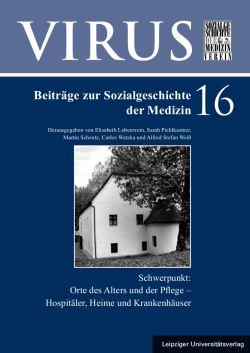 Elke Hammer-Luza
Elke Hammer-Luza
S. 155 - 168
doi:
10.1553/virus16s155
doi:
10.1553/virus16s155
Abstract:
Medical care in correctional facilities and penitentiaries has always been of particular importance, for various reasons: Maintaining the health of the inmates was not only an act of kindness, but also necessary to prevent epidemics and disease. After all, this was a precondition for the utilization of their labour. However, there were several complaints about shortcomings in medical care, particularly during the 18th century. Especially the sickroom equipment was in dire need of improvement and there were no notable positive developments in this area until the middle of the 19th century, due to the extremely limited space in all of the institutions in Graz. However, the care provided by medical staff was significantly better. Although it occurred that doctors and surgeons were apathetic and negligent, the inmates regularly received relatively good treatment. The Styrian rural population as well as the urban lower class of the (Early) Modern Period had few if any possibilities to be inspected by professionals, and therefore often turned to so-called quack doctors. Medical advice was expensive, just like the cost of medication. Although it was generally claimed that only low-cost remedies were used for convicts and other inmates in the 18th century, the expenditures for individuals sometimes exceeded what they were able to earn in an entire year. These aspects illustrate that inmates were not „second-class patients“, but even enjoyed advantages they would not have had as members of the lower rural or urban lower class outside of the institution. On the other hand the inmates had an increased risk of becoming ill because of the poor living conditions in the penal institutions.
Styria, Modern Period, microhistory, penitentiary, workhouse, jail, disease, care of the sick
Published Online:
2020/07/22 21:00:41
Object Identifier:
0xc1aa5576 0x003bb5cd
Rights:https://creativecommons.org/licenses/by/4.0/
Die Zeitschrift "Virus - Beiträge zur Sozialgeschichte der Medizin" ist das Publikationsorgan des Vereins für Sozialgeschichte der Medizin und erscheint einmal jährlich.
Sie versammelt wissenschaftliche Beiträge verschiedener Disziplinen, die sich mit Themen aus den Bereichen Medizin, Gesundheit und Krankheit in historischer, kultur- und/oder sozialwissenschaftlicher Perspektive empirisch auseinandersetzen. Weitergehende Einschränkungen für Beitragsvorschläge in thematischer oder methodischer Hinsicht bestehen nicht.
Der "Virus" publiziert vornehmlich Beiträge mit Bezug zur Geschichte der Medizin in Österreich, dessen Nachbarländern sowie der ehemaligen Habsburgermonarchie. Vergleichend angelegte Arbeiten können aber über diesen Rahmen auch hinausgreifen. Hinsichtlich der behandelten Zeiträume bestehen keine Eingrenzungen, jedoch stehen Beiträge zur Medizin in der Neuzeit und der Moderne/Postmoderne im Vordergrund (16.-21. Jahrhundert).
…




 Home
Home Print
Print
 References
References
 Share
Share
 Elke Hammer-Luza
Elke Hammer-Luza